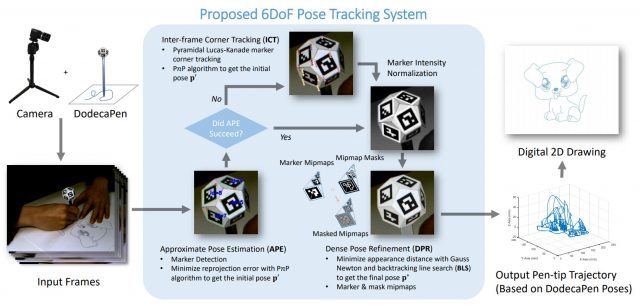Using a single camera and a 3D-printed dodecahedron decorated with binary square markers, the so-called ‘DodecaPen’ achieves submillimeter-accurate 6DoF tracking of a passive stylus. Lead by National Taiwan University PhD student Po-Chen Wu during his internship at Oculus Research, the work presents a low-cost tracking and input solution with many potential applications in virtual and augmented reality.
As shown in the video below, the ‘passive stylus’ in this case is an actual ball-point pen, allowing for a quick visual demonstration of the impressive accuracy of the tracking system, with the real and digitised drawings being almost indistinguishable from each other. Although the project focused on stylus applications, the video also highlights how the dodecahedron could be attached to other objects for virtual tracking, such as a physical keyboard.
According to the paper published on the NTU’s website, the DodecaPen’s absolute accuracy of 0.4mm is comparable to an advanced OptiTrack motion capture setup using 10 cameras—a combined resolution of 17 megapixels. The DodecaPen system achieves the same accuracy with a single, off-the-shelf, 1.3MP camera. The research clearly shows that marker corner alignment alone is not enough for robust tracking; the team instead used a combination of techniques detailed in the paper, including Approximate Pose Estimation and Dense Pose Refinement. The 12-sided shape was chosen to retain constant tracking quality, so that “at least two planes are visible in most cases.”
 The key advantage of the DodecaPen is its simple construction and minimal electronics, making it particularly suited to 2D and 3D drawing. However, the team recognises its limitations and drawbacks, being prone occlusion due to the single camera, and relying on a reasonable amount of ambient light to maintain accuracy. Also, the paper notes that their computer vision algorithm is ‘slow’ compared to 300-800Hz motion capture systems, as well as Lumitrack, another low-cost tracking technology. DodecaPen’s solution is limited by the fiducial marker recognition software and the motion blur generated by the camera, resulting in unwanted latency.
The key advantage of the DodecaPen is its simple construction and minimal electronics, making it particularly suited to 2D and 3D drawing. However, the team recognises its limitations and drawbacks, being prone occlusion due to the single camera, and relying on a reasonable amount of ambient light to maintain accuracy. Also, the paper notes that their computer vision algorithm is ‘slow’ compared to 300-800Hz motion capture systems, as well as Lumitrack, another low-cost tracking technology. DodecaPen’s solution is limited by the fiducial marker recognition software and the motion blur generated by the camera, resulting in unwanted latency.
The conclusion states that the system could “easily be augmented with buttons for discrete input and an inertial measurement unit to reduce latency and increase throughput.” A more complex stylus could also offer a better simulation of real drawing, including pressure sensitivity and tip tilt, which would make it better suited to emulate a pencil or brush rather than a pen. The problems of occlusion and limited low-light performance could be improved with multiple cameras with higher quality image sensors and lenses, but each upgrade would add to the system’s cost and complexity.
A made-for-VR stylus like the DodecaPen could prove to be a versatile tool for traditional productivity tasks in VR, which are largely limited today by a missing solution for fast and easy text input.






